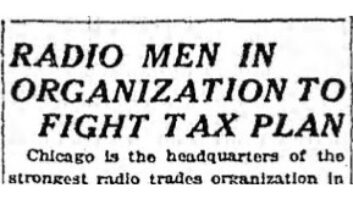
Author’s Note: April 16, 2024, marks the 100th anniversary of the founding of the CTA (Consumer Technology Association), which started as the RMA (Radio Manufacturers Association). This is the first in a series of essays exploring and celebrating CTA’s and our industry’s first century of invention, innovation, and entrepreneurship, assembled from varying technology historical research and writings I have done over the course of 20-plus years, including from an annually updated industry history for CTA’s now-defunct Digital America, 20-plus years of CTA Hall of Fame inductee biographies, and numerous tech history articles for a variety of publications over the years.
During my blissfully brief sojourn as a management/marketing consultant during the mid-1990s, I had occasion to meet with a group of young executives running an RCA off-shoot or licensed brand – I don’t remember which. During the initial meeting, I advised the assembled executives to recognize and possibly learn from the rich history of their brand, starting with RCA’s long-time chair, David Sarnoff.
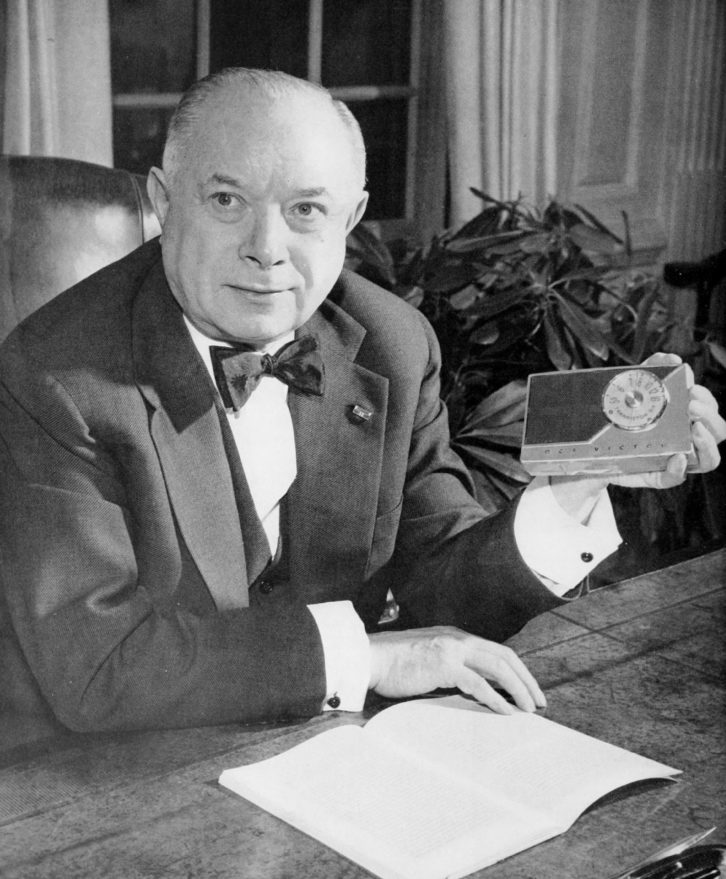
A pregnant silence followed. My mention of David Sarnoff, the single most important and dominant executive in the history of the RCA brand if not our industry, was met by a conference table full of blank stares. Forced to spend five minutes or so explaining who David Sarnoff was to a group of executives representing RCA, it was all I could do to suppress both my anger and sadness that readily available lessons on how their own brand and our industry were built and became successful were so quickly lost.
Upon reflection, I realized I can’t really blame the executives. In our short attention span culture, history is unfortunately considered more Jeopardy! trivia than essential business operation intel. In the world of business and industry, including the consumer electronics industry, it is stunning how little understanding there is about how and why devices, technologies, and companies have been successfully developed, marketed, and deployed, all of which could provide key lessons to help ensure future success and avoid failure of new ventures.
See also: Kinsey Fabrizio Named President Of Consumer Technology Association

One major aspect of our industry that nags at me is its emphasis on things rather than people. When folks speak of the “consumer electronics” or “consumer technology” industry, the Pavlovian response is, well, the electronics and technologies: smartphones, TVs, video games, headphones, smart home, et al. But none of the gadgets we plug in, pair, or deploy sprung whole like Athena from the head of Zeus.
Imaginative and driven human beings – inventors, engineers, entrepreneurs, marketers, sales staff, retailers, and CEOs around the world – all with fascinating and illuminating stories, worked diligently for weeks, months, and years, on every device and technology in our home. This conglomeration of geniuses, innovators, builders, dreamers, and even a few scallywags, exhibited motives ranging from naively egalitarian and utopian to simply greedy and occasionally unscrupulous, and employed proactive and reactive means and methods to achieve business goals running the full ethical, moral, and legal gamut.
It is these fascinating human beings behind our high tech, along with both the intended but usually unintended consequences of new disruptive tech, that supply the unfortunately lost yet invaluable lessons contained within the history of CTA and the consumer electronics industry.
The Age of Radio
Laying the foundation for what would become CTA was the rapid morphing of radio from military and commercial wireless telegraphy to consumer sound broadcasting in the years immediately following World War I. This transformation of wireless telegraphy into a new consumer electronics business was led primarily by GE chair Owen D. Young and Westinghouse executives Frank Conrad and Harry Philips Davis.
You can read about the post-WWI/pre-commercialization development of radio starting here:
Part 1: The Wireless Age
Part 2: A National Priority
Part 3: A Pittsburgh Radio Sensation
Part 4: The Birth of a Business
Part 5: “When The Public Is Ready For Mass Demand”
The Radio Explosion

To say that the radio business exploded after its introduction as a consumer product in late 1920 is an understatement. Thanks to the simultaneous introduction of both radio hardware and content – radio stations – in the early 1920s, the consumer uptake of this first consumer electronics product was shockingly fast even by today’s standards, especially when you consider the inherent limitations of its adoption.
In 1920, only around a third of America’s approximately 25 million households were wired for electricity – and only 2% of farms, who had the biggest need for up-to-the-minute weather and crop pricing that radio provided. The only electrical AC “outlets” in these electrified homes were incandescent light bulb fixtures. To plug in to power a radio or charge a radio’s lead acid battery, a consumer had to unscrew a light bulb and plug in an adapter. Wall AC outlets would not become standardized and ubiquitous for several years, development spurned by radio’s rapid adoption.
Plus, these early radio sets weren’t exactly cheap. In 1924, a radio could cost nearly as much as a Ford Model-T car – around $290 – at a time when U.S. annual household income averaged around $1,300.
See also: CTA Celebrates 100 Years Of Igniting Innovation
Despite the consumer market, infrastructure, and economic roadblocks for this first consumer electronics device, Americans spent $60 million ($1.1 billion in 2024 dollars) on radio sets in 1922, only the second full year consumer radio sets were available. By 1929, spending on home radios reached nearly $850 million ($15.3 billion in 2024 dollars) thanks mainly to competition from myriad makers forcing radio set prices to fall below $50. Around 35-40% of American homes owned a radio by the end of the 1920s, likely a higher household penetration rate than indoor plumbing.
At first, RCA branded and sold radios manufactured by Westinghouse before beginning to develop and manufacture its own sets. RCA was followed into the radio hardware business by brands such as Crosley, Atwater Kent, Zenith, Shure, Philco, and Motorola, which created the first practical car radio.
Stores to sell these new radios also started springing up like weeds across the country. Most prominently, on Cortlandt Street in downtown New York City, later the site for the World Trade Center twin towers, two radio stores, City Radio and Furst Radio, opened in 1921. These two radio stores were quickly followed by dozens of other radio retailers to create a boisterous and cacophonous six-block area that would soon become known as Radio Row.
Founding a Lobbying Organization
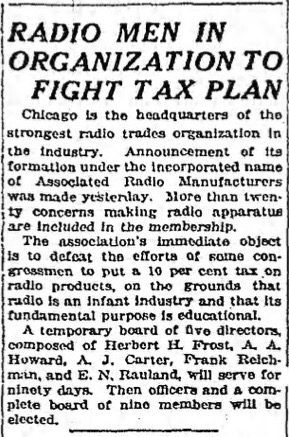
The explosive popularity of radio naturally attracted government and political interest. President Calvin Coolidge and then commerce secretary and eventual president Herbert Hoover were boosters of the new technology. A more fiscally threatening interest was Congress, which proposed a 10 percent federal tax on the radio to help settle World War I debt. Emerging radio makers, stations, and radio listeners across the country were aghast that what would amount to a 20 percent price hike on already still expensive gear could kill sales and industry growth.
On April 16, 1924, a handful of Chicago radio makers were granted a charter by the state of Illinois to form the Associated Radio Manufacturers. Two days later, on a cool, overcast Chicago Friday night, April 18, 1924, representatives of 17 local radio companies assembled for a dinner meeting at Chicago’s Sherman Hotel to formalize the association, adopt an organizational structure, constitution, and by-laws, establish membership fees – $100 – and figure out how to fight the proposed tax on radios and solve other lingering patent licensing and standards issues.
Within a few weeks, the organization’s name would be changed to the Radio Manufacturers Association (RMA). Four days after the inaugural dinner, a temporary board of directors unanimously elected Chicago radio parts maker Herbert H. Frost the first RMA chair [see sidebar: “CTA’s George Washington”]. On June 23, Frost was elected RMA’s first president.
Fighting the Tax
Ten days after its founding, RMA dispatched its legal counsel, Ernest Reichmann, to Washington. As Reichmann’s train traveled to the nation’s capital, the radio tax, having already passed the Senate Finance Committee, was incorporated into an omnibus revenue bill.
Upon arrival in D.C., Reichmann immediately began lobbying senators, battling their mistaken belief that RCA controlled 90% of the radio industry’s massive profit and therefore could easily afford to pay the excise tax. Since RMA represented mostly smaller radio companies, Reichmann managed to convince enough senators on the harm the tax would cause to the young industry and the startup businesses it was spawning.
On May 2, the Senate voted 40-13 to remove the radio tax. The RMA had scored its first legislative victory, albeit a relatively brief one. A 5% federal tax was finally imposed in 1932, raised to 10% in 1939.
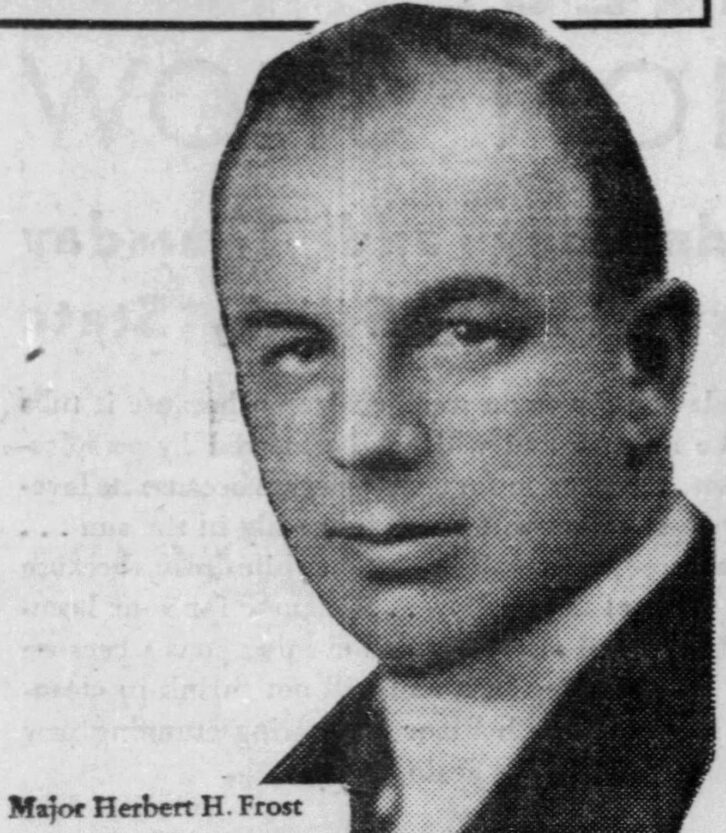
“That fight taught us that the interest of the manufacturer, the listener, and the broadcaster are identical,” RMA president Frost crowed after RMA’s initial legislative victory. “We are now organized, the listeners are organizing, and so will the broadcasters. [Note: the National Association of Broadcasters (NAB) was founded in April 1923, also in Chicago.] Then all can work together with other elements of the industry to prevent these attacks.”
Within weeks, RMA grew to 46 member companies. That fall, from September 22-28, 1924, more than 175,000 people – including Thomas Edison and Nikola Tesla – attended the first Radio World’s Fair at New York City’s Madison Square Garden and the 69th Regiment Armory, the first of many radio exhibitions staged in both New York and Chicago.
RMA was not a sponsor of this first Radio World’s Fair or other early radio conventions, mostly organized and managed by U.J. “Sport” Herrmann. But in March 1925, RMA completed a deal to grant radio fair organizers official RMA imprimatur for a share of the profits. The first two of these neo-CESs held under RMA’s name in Chicago’s Coliseum and at The Bronx’s 258th Field Artillery Armory in New York in the fall of 1925 netted RMA a tidy $4,500 profit – nearly $80,000 in 2024 dollars. In 1926, RMA moved its fall New York radio fair to the then “new” Madison Square Garden at 50th Street and Eighth Avenue.
RMA also held its first convention on July 10-11, 1925, in Atlantic City, a mix of serious organizational and operational business as well as golf and likely equally serious “Broadwalk Empire” style Jazz Age partying. By 1927, RMA had grown in both size and influence. It operated not only its Chicago HQ, but offices in New York and Washington, D.C., and membership had ballooned to 295 companies. That same year, RMA persuaded Congress to accept 90% of its recommendations for the landmark 1927 Radio Act that established the Federal Radio Commission, the forerunner of the FCC (1934).
Radio Business Growth
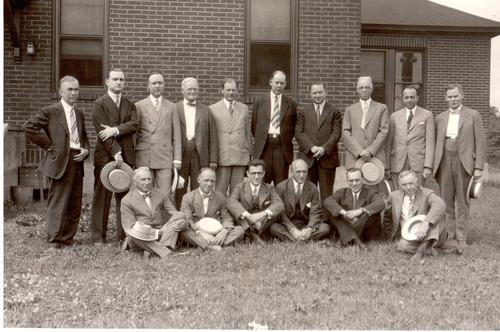
As the radio industry grew, so did the variety of radio products. There were radios requiring headphones and cabinet sets with built-in speakers, there were old-style crystal radios and there were new-fangled vacuum tube radios, there were compact tabletop sets, fancy and expensive furniture models, radio/record player combinations, and every type of configuration and price in between. By the end of the 1920s, most radios were AC- rather than battery-powered, with one-knob tuning and higher-fidelity cone speakers, and record players had gone from wind-up mechanical operation to fully electrical to become the consumer electronics industry’s second product.
The federal government soon recognized the national economic value of radio, if not its value as a political tool. At RMA’s second Atlantic City convention in May 1926 in Atlantic City, Frost read a personal message from President Calvin Coolidge, who promised that “this government stands ready to do what properly may be done to encourage the development of radio.”
Television

Radio and the phonograph remained the two major product categories for the industry up until World War II. But a brand-new consumer electronics product had already hit the drawing boards almost as soon as RMA and the radio business took off.
A few months after his election to a third term as RMA president in 1928, Frost announced an RMA exploratory committee to examine the possibilities for this new electronics product.
“Television is the next great step in the development of radio art,” Frost predicted, “but the public must not be misled by experiments being carried on at this time. Practical television is still a few years away.”
Significant Dates:
1924
- Western Electric patents Westrex, its electrical sound recording.
- Zenith produces the first portable radio
- AT&T experiments with a radio car telephone.
1925
- Victor Talking Machine begins selling the first AC-powered phonographs and radio/Victrola combinations.
- The first electrically recorded phonograph records are released.
- Bell Labs, which would become the world’s largest industrial research lab, begins operations in New York City. (January 1)
- Vladimir Zworykin files for a color TV patent. (July 13)
- RCA introduces the Radiola 30, the first mass-produced radio designed to run only on AC power, from a light bulb socket. (September 1)
- John Logie Baird produces a TV picture of human faces. (October 2)
1926
- Zenith introduces AC-powered radio receivers.
- John Logie Baird files a British patent for mechanically recording video on a phonograph disc. (October 15).
- NBC, the first national radio network, goes on the air. (November 15)
- Kenjiro Takayanagi demonstrates a cathode ray TV system using a mechanical Nipkow disk in Japan. (December 25)
1927
- Broadcast of the Rose Bowl on NBC, the first coast-to-coast radio hookup. (January 1)
- AT&T establishes commercial transatlantic telephone service between North America and Europe. (January 7)
- Russian Boris Rtcheouloff applies for a British patent for magnetic video recording. (January 4)
- Philo Farnsworth applies for a patent on his all-electronic television system. (January 27)
- The Federal Radio Commission, the forerunner of the FCC, is established, as part of the Radio Act of 1927. (February 23)
- Bell Telephone Laboratories demonstrates wireless TV between Washington, D.C., and New York City, featuring a speech by U.S. Commerce Secretary Herbert Hoover. (April 7)
- Philo T. Farnsworth demonstrates all-electronic television. (September 7)
- JVC founded in Yokohama, Japan. (September 13)
1928
- RMA adopts a patent interchange agreement to allow member manufacturers to share minor radio patents and end litigation. (June 13)
- The first commercially licensed TV station, W3XK in Washington, D.C., owned by inventor Charles Francis Jenkins, started broadcasting. (July 2).
- John Logie Baird first demonstrates color television. (July 3)
- Galvin Manufacturing – Motorola – founded. (September 25)
1929
- AT&T engineers Lloyd Espenschied and Herman Affel file a patent for a “concentric conducting system” – aka coaxial cable. (May 23)
- RCA purchases Victor Talking Machine Company and becomes RCA Victor. (October 26)
About the Author
Stewart Wolpin has been covering the consumer technology industry for more than four decades, including for TWICE since its founding. He’s authored a slew of technology history articles and has written the bulk of the biographies of the Consumer Technology Association Hall of Fame inductees. He’s also written “Bums No More: The Championship Season of the 1955 Brooklyn Dodgers,” and “The Rules of Neighborhood Poker According to Hoyle.” You can see his technology reportage, historical and current, at stewartwolpin.com.
See also: CES 2024 Audience Audit Reveals Who Attended The Show






